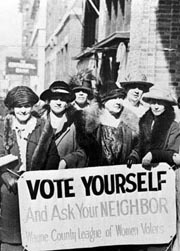
Tuesday, November 4, is Election Day in America. We all know that voting is the bedrock of democracy. In fact, the word itself means "people power," from the Greek: demos meaning "the people" and kratia meaning "power."
If you want to feel really good on the Wednesday after Election Day, regardless of the results of the vote, wake up knowing that you brought something extra to our national exercise of people power.
This year, take on the challenge of persuading five other women to join you in going to the polls -- women who may think they are too busy, have to pick up kids at day care or just don't think they are interested in "politics."
Women already bring something extra to the voting booth. Women vote more than men in almost every demographic and age group. According to the Center for American Women and Politics at Rutgers, 63 percent of eligible women voted in 2012 compared to 59.7 percent of eligible men. Women vote in greater numbers in off year elections as well.
Women also tend to vote differently than men. The gender gap is the difference between women and men voters in support of a candidate. It is clear that women's votes have determined the outcomes in many recent elections including the election of Barack Obama in 2012 with a gender gap in his favor of 10 points.
Women's votes also helped elect a record 20 women to the U.S. Senate in 2012.
But a turnout of 63 percent of eligible women voters still leaves 37 percent of women on the sidelines. That's too many voices to be silent!
Vision 2020, a coalition of individuals and organizations in support of gender equality for women -- in leadership, economic security and civic engagement -- has called for 100 percent turnout of eligible women voters in the year 2020. This would be a fitting tribute to the valiant women who managed to secure passage of the 19th Amendment in 1920, finally adopted into law almost 100 years ago and 133 years after the Constitution was signed.
Many scoff at this goal. "You can't possibly turn out 100 percent of eligible women voters," say some. "That is an outrageous goal," say others. These objections are not new. They are reminiscent of the arguments hurled at Susan B. Anthony, Elizabeth Cady Stanton, Alice Paul and the tens of thousands of dedicated suffragists who fought for women's right to vote.
Yet women's voices mattered then and they matter now. Women voters are not a unified voting bloc. But women do tend to support access to health care, gun control, and providing greater government support, like food stamps and early childhood education, for vulnerable children. These are some of the most important policy issues of our time and women's votes can make the difference.
Let's make 2014 a test run for the goal of 100 percent turnout of women voters in the centennial year of 2020. Let's practice our ability to persuade the women among our colleagues, neighbors and friends who are reluctant, disaffected or just unmotivated to raise their voices and use their votes.
Make a promise to yourself and to our shared future to get five of that missing 37 percent of women voters to the voting booth on Tuesday, Nov. 4.
And then, let's see what happens.
